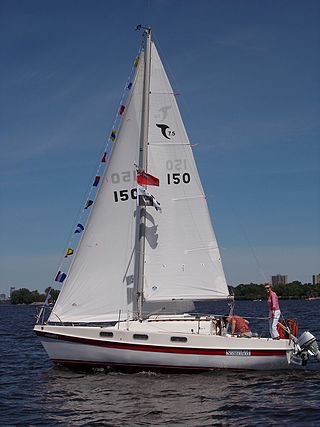Related Research Articles
The Westerly 22 is a British trailerable sailboat that was designed by Denys Rayner as a cruiser and first built in 1963.

The Tanzer 7.5 is a Canadian trailerable sailboat, that was designed by Johann Tanzer and first built in 1977. The design went out of production in 1985.
The Balboa 24 is an American trailerable sailboat that was designed by W. Shad Turner and William Downing as a racer-cruiser and first built in 1981.
The Bristol Caravel 22, sometimes called the Bristol 22 Caravel, Sailstar Caravel, or just the Caravel 22, is an American trailerable sailboat that was designed by Halsey Chase Herreshoff as a cruiser and first built in 1968. It is named for the class of sailing ship.
The Clipper 23, also called the Clipper Marine 23, is an American trailerable sailboat that was designed by William Crealock and first built in 1976.
The Ensenada 20 is an American trailerable sailboat that was designed by Lyle C. Hess as a cruiser and first built in 1972.
The Helms 24 is an American trailerable sailboat that was designed by Stuart Windley as a cruiser and first built in 1977.
The Lancer 25 is an American trailerable sailboat that was designed by W. Shad Turner as a cruiser and first built in 1975.
The O'Day 240 is an American trailerable sailboat that was designed by C.R. Hunt & Associates as a cruiser and first built in 1988.

The Pearson 24 is an American trailerable sailboat that was designed by William Shaw as a cruiser and first built in 1967.
The S2 7.0 is an American trailerable sailboat that was designed by Arthur Edmunds as a cruiser and first built in 1975. The designation indicates the approximate length overall in meters.
The Seidelmann 25 is an American trailerable sailboat that was designed by Bob Seidelmann as a racer-cruiser and first built in 1977.
The Sovereign 23 and Sovereign 24 are a family of American trailerable sailboats that was designed by Arthur Edmunds as cruisers and first built in 1981.
The Tylercraft 24, also called the Tyler 24, is an American trailerable sailboat that was designed by Ted Tyler as a cruiser and first built in 1961.
The Venture 222 is an American trailerable sailboat that was designed by Roger MacGregor as a cruiser and first built in 1971.
The Vivacity 20 is a British trailerable sailboat that was designed by Peter Stevenson and Des C. Pollard as a racer-cruiser and first built in 1963.
The Walton 25 is a trailerable sailboat first built in 1961. It was sold under a number of names, including Continental Folkboat, Whitby 25 Folkboat, Great Lakes Folkboat as well as Walton 25.
The Tiger 25 is a British trailerable sailboat that was designed by John A. Butler as a cruiser and first built in 1969.
The Windrose 18 is an American trailerable sailboat that was designed by W. Shad Turner as a cruiser and first built in 1974.
The Yankee 26 is an American trailerable sailboat designed by Sparkman & Stephens as an International Offshore Rule Quarter Ton class racer-cruiser and first built in 1974. The boat is Sparkman & Stephens design #2065.1.
References
- 1 2 3 4 5 6 7 McArthur, Bruce (2022). "Nomad 22 (Westerly) sailboat". sailboatdata.com. Archived from the original on 22 March 2022. Retrieved 22 March 2022.
- ↑ McArthur, Bruce (2022). "Denys Rayner". sailboatdata.com. Archived from the original on 22 March 2022. Retrieved 22 March 2022.
- 1 2 3 4 5 6 7 8 9 10 Henkel, Steve: The Sailor's Book of Small Cruising Sailboats, page 212. International Marine/McGraw-Hill, 2010. ISBN 978-0-07-163652-0
- ↑ McArthur, Bruce (2022). "Westerly Marine Construction Ltd. 1964 - 2000". sailboatdata.com. Archived from the original on 22 March 2022. Retrieved 22 March 2022.
- ↑ McArthur, Bruce (2022). "Westerly Owners Association". sailboatdata.com. Archived from the original on 22 March 2022. Retrieved 22 March 2022.